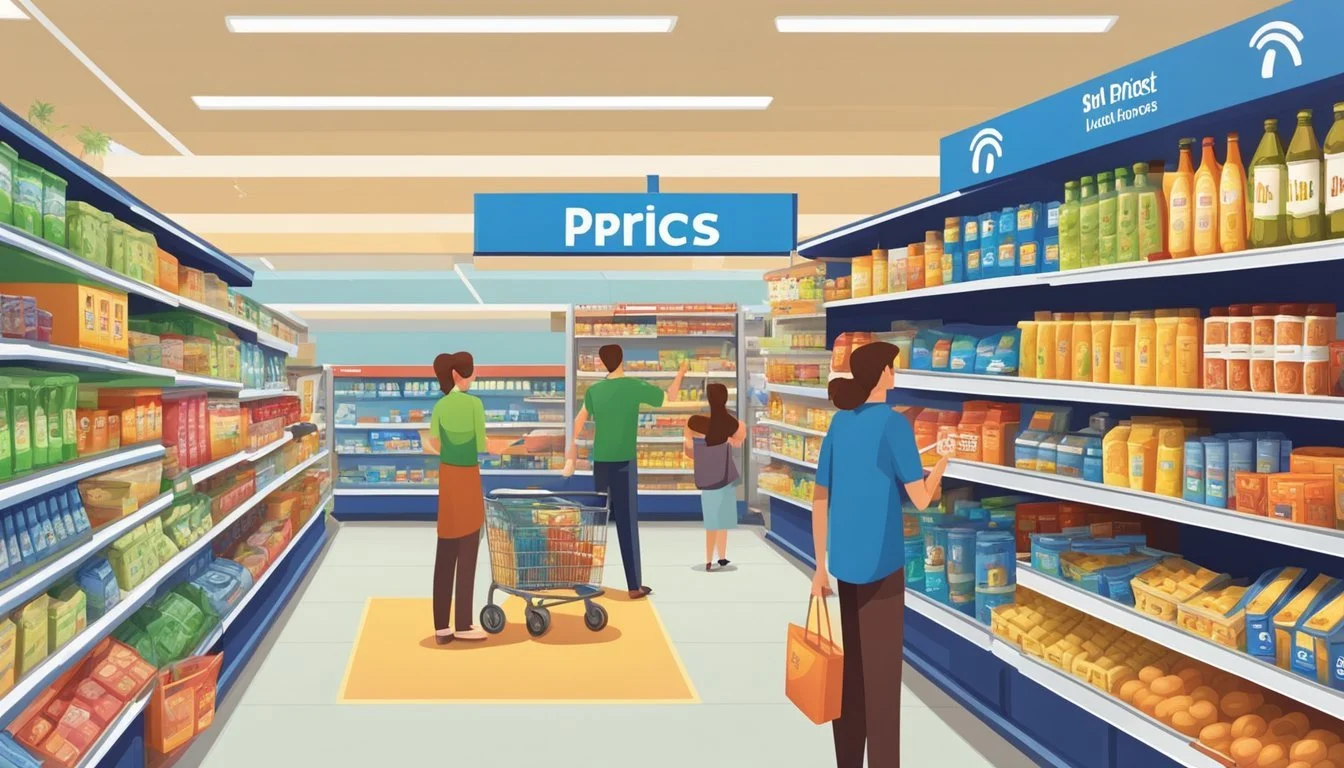Is Walmart Cheaper Than Lidl?
Comparing Discount Retail Prices
Part of Our Grocery Store Guide with Details on Walmart Prices and Lidl Prices
When determining where to get the best value for one's grocery budget, Walmart and Lidl often come to mind as two popular contenders. As both retailers are revered for their low prices, consumers frequently ponder which one offers the ultimate cost-saving experience. Walmart, known for its extensive network of locations and vast product selection, is said to be more affordable in certain shopping categories such as beverages, baking goods, dairy, dry goods, and miscellaneous items.
On the other hand, Lidl, a grocery chain that has made its mark by offering high efficiency and a different shopping experience, is noted for having better prices in the realms of canned goods, frozen foods, personal care products, and cleaning supplies. While Walmart's reach allows it to operate on a scale that can lead to greater cost reductions, Lidl's business model emphasizes a streamlined selection, potentially leading to competitive pricing from their vendors and quicker shopping trips for consumers.
The assessment of which store is cheaper does not yield a straightforward answer; it hinges on the categories of items shoppers are interested in and the importance of store efficiency versus product variety. Both Walmart and Lidl have carved out niches that resonate with value-seeking customers, making it necessary to consider personal shopping preferences and geographic availability when deciding where to shop.
Comparing Walmart and Lidl Overview
In analyzing Walmart and Lidl, a scrutinized look into pricing, store network, product selection, business practices, quality, shopping experience, and loyalty incentives provides valuable insights into their competitive landscape.
Price Comparison Fundamentals
Walmart and Lidl are both known for offering savings to their customers, with Walmart often being cheaper in categories such as beverages, baking goods, dairy, dry goods, and others. By contrast, Lidl tends to have lower prices in canned goods, frozen foods, personal care, and cleaning products.
Store Location and Presence
Walmart's presence is ubiquitous across the U.S., encompassing a wide geography that includes the East Coast, Midwest, and Southeast. On the other hand, Lidl's U.S. stores are predominantly located on the East Coast, with an eye on expanding its reach.
Range of Products Offered
Walmart offers a vast array of products, from electronics to home goods, alongside their comprehensive selection of food items, including both national brands and store brands. Lidl, with a focus on groceries, provides high-quality products, especially in the dairy, meat, and produce aisles.
Supermarket Business Models
Lidl operates on streamlined operations, offering competitive pricing by minimising overhead and featuring mainly their private label offerings. Walmart, recognized as a supercenter, attains cost savings through economies of scale, providing low prices across a broader spectrum of national and private label brands.
Quality and Freshness of Goods
Both Walmart and Lidl assert a commitment to quality and freshness, especially within the fresh produce category. Lidl is often touted for high-quality and organic produce options, while Walmart meets a consistent standard for freshness across its wide selection.
Shopping Experience and Services
The shopping experiences at Lidl and Walmart vary, with Lidl focusing on efficiency and ease of navigation within their stores. Walmart provides a diversified experience by also including services like pharmacies and vision centers and offers Walmart+, their membership program with various services and perks.
Discounts and Loyalty Programs
Walmart promotes savings through rollback prices and a subscription service, Walmart+, which includes benefits like free delivery and fuel discounts. Lidl's discounts often come from in-store promotions, and the "MyLidl Rewards" loyalty program rewards customers for their frequent purchases.
Market Position and Competitive Analysis
This section delves into the battle for affordability and market presence between Walmart, the established retail leader, and Lidl, the German supermarket chain making bold strides in the competitive grocery sector.
Walmart’s Market Dominance
Walmart is often perceived as the epitome of low prices and vast selection in the retail space. This supermarket chain holds a substantial share of the US market, benefiting from economies of scale that allow for competitive pricing strategies. Walmart's aggressive pricing and expansive store network keep it at the forefront of the supermarket hierarchy.
Lidl’s Market Position and Growth
Lidl, the German grocer known for its deep discounts and no-frills shopping experience, has been actively expanding its footprint beyond Germany and into markets like France and the United States. Lidl's growth trajectory is characterized by a strategy of offering quality products at affordable prices, enticing customers who prioritize savings.
Comparative Analysis of Grocery Prices
When comparing grocery prices, a pivotal metric in gauging the cheapest grocer, studies suggest that the presence of Lidl can influence nearby chains, including Walmart, to lower their prices. For example, Lidl's impact has been observed with staple items like milk, where prices can drop significantly in markets where Lidl operates.
Grocery Item Walmart Price Lidl Price Milk $X.XX $X.XX Bread $X.XX $X.XX Eggs $X.XX $X.XX
Prices are exemplified and may vary by location.
Impact of Competition on Grocery Chains
The competition between grocery chains such as Walmart and specialty grocers like Lidl is fierce. They are continually adapting their strategies to maintain or capture market share. Walmart's response to Lidl's low-price offerings includes not only price reductions but also enhancements to their shopping experience and product variety.
Customer Preferences and Perceptions
Shoppers' preferences are influenced by many factors including price, convenience, and shopping experience. US shoppers, including families and individuals, tend to prioritize affordable prices, but they are increasingly valuing quality and convenience. The ongoing competition between Walmart and Lidl has the potential to shift perceptions of what constitutes value among supermarket chains.
Demographics and Geographic Influence
The competition in pricing between Walmart and Lidl can be significantly impacted by demographic factors and geographic presence, affecting shopper preferences and store expansion strategies.
Shopper Demographics at Walmart and Lidl
Walmart's customer base is traditionally diverse, reflecting its status as the largest retailer in the world. The average Walmart shopper may not be easily pinned down to a single demographic, however, available data suggests they encompass a wide age range, with a lean towards families and individuals across various income levels. Lidl, a European-based grocery chain, attracts a demographic that appreciates its lower-priced yet high-quality store-brand alternatives, often appealing to budget-conscious consumers.
Walmart Shopper Profile:
Age: Broad range
Income: Appeals across various income levels
Family Status: Attracts families and individuals
Frequency: High customer loyalty with frequent visits
Lidl Shopper Profile:
Age: Typically targets a cost-conscious demographic
Income: Lower to middle-income families
Family Status: Likely to attract smaller households looking for value
Geographical Presence and Expansion
Walmart has a pervasive presence across the United States and has made its mark in regions like the Southeast, Midwest, and East Coast, including metropolitan areas such as the Atlanta metro area. Walmart's ubiquity in the U.S. market positions it well to appeal to a broad section of US shoppers. Lidl, on the other hand, while well-established in Europe, has been expanding on the East Coast of the US. Both retailers choose store locations strategically but face different challenges and opportunities based on their respective market penetrations.
Walmart Geographic Presence:
Nationwide coverage with a heavy concentration in Southeast and Midwest regions
Large number of locations: Expansive network reaching a broad demographic
Lidl Geographic Presence:
Initially focused on East Coast expansion in the US
Recent growth: Aiming to appeal to US shoppers with a model proven successful in Europe
Shopping Categories and Specifics
When comparing Walmart and Lidl, one must consider varying factors like product quality, product variety, and price across different shopping categories such as perishable goods, non-perishable and dry goods, and specialty products.
Perishable Goods: Dairy, Meat, and Bakery
Walmart offers a wide variety of dairy products such as milk and cheese, with competitive pricing often making it a go-to for many shoppers. The meat selection in Walmart is expansive, catering to various tastes and preferences. As for bakery items, customers can find a range of bread and baked goods, with a focus on affordability and freshness.
Non-Perishable and Dry Goods
Lidl has a reputation for providing cost-effective options in the realm of canned and dry goods. Their shelves are often stocked with both name-brand and private-label baking goods at prices that challenge those of Walmart. Additionally, Lidl’s canned goods section is known to offer budget-friendly choices that don’t compromise on quality.
Specialty Products and Dietary Options
Both retailers present an assortment of specialty products, including organic produce and gluten-free options. Walmart boasts a significant product variety, including a range of high-quality products that cater to specialized dietary needs. Lidl offers a curated selection of specialty items, often at lower prices, which includes fresh and organic produce that appeals to health-conscious consumers.
Services and Shopping Technologies
Walmart and Lidl provide customers with various services and shopping technologies aimed at enhancing the shopping experience, including both in-store and online shopping facilities, as well as membership and rewards programs.
In-store and Online Shopping Services
Walmart leverages technology such as Gen AI, augmented reality (AR), and virtual reality (VR) to streamline the in-store experience for shoppers. Customers can use their mobile devices to navigate through the store, check prices, and even complete a purchase without standing in the traditional checkout line. For online shopping, Walmart offers home delivery and in-store pickup options, enabling customers to shop on their terms.
Lidl, on the other hand, focuses on efficient in-store layouts to aid shoppers in finding their items quickly. While Lidl's usage of in-store technology is not as prominent as Walmart's, they too offer an online shopping cart experience through their websites in some regions, although the home delivery service is more limited compared to Walmart.
Membership Programs and Reward Systems
Walmart+ is a subscription service that competes directly with Amazon's Prime membership. It includes benefits like unlimited free delivery, member prices on fuel, and Mobile Scan & Go for contactless shopping. This membership is designed to provide value and convenience for Walmart's frequent shoppers.
Lidl offers its own rewards through the MyLidl program which provides personalized coupons, special offers, and the potential to influence future store products. This system fosters a sense of community and a personalized shopping experience for Lidl customers.
Both retailers' reward systems are crafted to build loyalty and enhance the overall shopping experience by offering value beyond the point of sale.
Financial Considerations and Impact
In the context of retail shopping, Walmart and Lidl are significant players whose price strategies influence both market prices and consumer spending behavior.
Price Wars and Their Effects on Prices
Walmart frequently engages in competitive pricing, often emerging as the more affordable option in several shopping categories including beverages, baking goods, dairy, dry goods, and miscellaneous items. On the other side, Lidl has been found to offer lower prices in canned goods, frozen foods, personal care, and cleaners. These price wars between Walmart and Lidl not only affect the prices within their stores but can also lead to widespread retail adjustments, as competitors strive to maintain customer loyalty through affordable prices.
Economic Impact on Consumer Spending
Consumers often benefit from the competition between Walmart and Lidl, as the battle for the lowest prices can lead to savings on everyday purchases. This competition particularly impacts consumer spending by making a wider range of goods more accessible at lower prices, thereby expanding their purchasing power. The economic impact is such that, in areas where these retailers directly compete, the resulting price reductions in essential commodities like milk can significantly influence the overall cost of living for consumers.
Consumer Behavior and Trends
In analyzing the competitive landscape between Walmart and Lidl, it's crucial to understand the behavioral patterns of consumers and the evolving trends impacting the grocery shopping experience. These insights shed light on how each brand aligns with US shoppers' preferences.
Identification of Shopping Habits
US shoppers display distinct shopping habits when choosing between grocery chains like Walmart and Lidl. Walmart tends to attract customers looking for a wide range of products, including beverages, baking goods, dairy, and dry goods. Lidl, on the other hand, appeals to those seeking cost savings in canned goods, frozen foods, personal care, and cleaning products. This diverts their focus from solely price comparison to considering the value obtained from each retailer's offerings.
Walmart:
Be on the lookout for competitive prices.
Draws customers with a broad product assortment.
Lidl:
Attracts shoppers with budget-friendly options in select categories.
Known for quality in specific ranges like organic produce.
Trends in Grocery Shopping and Retail
Trends indicate that US shoppers are not just swayed by prices but also by shopping experience and convenience. Both Aldi and Trader Joe’s have also contended in this sector by emphasizing quality and unique product lines, such as fresh and organic produce. These grocers have carved out loyal consumer segments who prioritize product quality alongside value for money.
Grocery Shopping Trends:
Emphasis on quality and convenience.
Growing preference for fresh and organic produce.
Adapting to Shifting Consumer Preferences
Grocery chains must adapt to the significant shifts in consumer preferences revealed by recent behaviors. More than half of US consumers reportedly intend to avoid crowds and unnecessary travel, which affects their choice of retailer. Customers also show a tendency to spend less time inside stores. Adapting to these preferences, retailers need to streamline the shopping experience and prioritize customer safety and convenience.
Shifting Consumer Preferences:
Enhanced focus on shopping efficiency.
Growing inclination towards safety and convenience in retail environments.
It's evident that such behavioral insights can empower retailers like Walmart and Lidl to effectively tailor their strategies to meet the expectations of US shoppers, maintaining a competitive edge in the grocery retail market.
Supplier and Manufacturer Relationships
When comparing Walmart and Lidl, understanding their respective strategies in working with suppliers and managing product quality is key to analyzing their market position as competitive supermarket chains.
Walmart’s Supplier Strength
Walmart's clout with suppliers gives it a significant edge to maintain its low-price leadership. As one of the largest supermarket chains, Walmart wields substantial bargaining power which often results in the lowest possible purchase prices for the company. This ability to negotiate harder and command lower prices from its vast number of suppliers allows Walmart to keep its costs down, and, in turn, offer competitive pricing to its customers.
Bargaining Power: Negotiates aggressively with suppliers to achieve the lowest prices.
Scale of Operations: Uses its extensive network to distribute products efficiently.
Lidl’s Procurement Strategies
Lidl, a German grocer, adopts a different approach, focusing on a leaner product selection with a strong emphasis on private label offerings. By limiting the range of products, it cuts down on negotiating time and complexity with multiple suppliers. A curated selection of high-quality products allows for more straightforward procurement processes, potentially leading to more favorable pricing on what it does offer.
Private Label Focus: Prioritizes in-house brands over national ones to streamline supply.
Product Selection: Offers a limited range to simplify and optimize supplier relationships.
Quality Control and Brand Partnerships
Both Walmart and Lidl place a considerable emphasis on the quality of products. Walmart assures this through partnerships with reputable national brands and strict quality control measures. In contrast, Lidl ensures high-quality products primarily through its private labels, allowing for more direct oversight of production and quality standards.
Walmart:
Partners with well-known national brands.
Implements strict quality control measures.
Lidl:
Focuses on high-quality private labels.
Maintains direct oversight of production standards.
Future of Grocery Retail
The future of grocery retail is largely shaped by the proliferation of technology and shifting consumer behavior. Retail giants such as Walmart and Lidl compete vigorously in adapting to market trends and improving the shopping experience.
Innovations in Grocery Shopping
Walmart and Lidl are investing in technology to enhance the efficiency and convenience of shopping. Walmart+, for instance, offers benefits such as free home delivery, reflecting the importance of online commerce. Both stores are exploring automation to streamline checkout processes and restocking. Market trends show a significant inclination toward tech-based solutions such as:
Self-checkout kiosks: Reducing wait times for customers.
Mobile apps: Providing personalized shopping experiences and easier payment methods.
The impact of technology on competition in the grocery retail market is substantial, with companies that embrace innovation staying ahead.
Potential Changes in Consumer Behavior
US shoppers, including families, are increasingly prioritizing convenience and speed. This has led to a rise in home delivery services and curbside pickup. Consumer behavior suggests:
A growing preference for online shopping over traditional in-store purchases.
Sensitivity to price changes with a willingness to switch brands or stores for better deals.
Walmart and Lidl might adapt their marketing strategies to target these behaviors, influencing competition and potentially changing the landscape of grocery retail for other market participants.
Conclusion
In comparing Walmart and Lidl, shoppers often find variations in prices between the two retail giants. Walmart tends to offer lower prices in categories such as beverages, baking goods, dairy, dry goods, and miscellaneous items. Shoppers aiming to maximize their savings on these items may gravitate towards Walmart for its cost-effectiveness.
On the other hand, Lidl provides more affordable options particularly in the realms of canned goods, cleaning supplies, frozen foods, and personal care products. For consumers who prioritize savings in these categories, Lidl emerges as a compelling choice.
The shopping experience also varies between the two stores, with Walmart providing a broader range of goods and frequent promotions, while Lidl offers a streamlined selection that often leads to faster shopping trips. Quality of products is consistent at both retailers, with each having their own house brands and premium options.
Consumers seeking the best value for money might find it advantageous to shop at both stores, selecting specific categories from each based on where the savings are greatest. In terms of affordability, no retailer is universally cheaper across all products, compelling savvy shoppers to keep an attentive eye on where they can procure the best deals.










